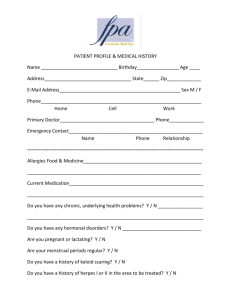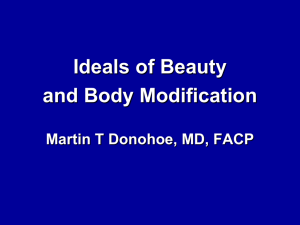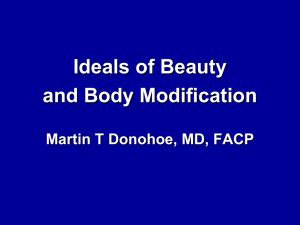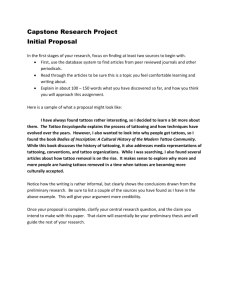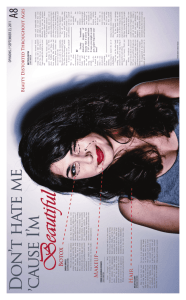Historical Ideals of Beauty
advertisement
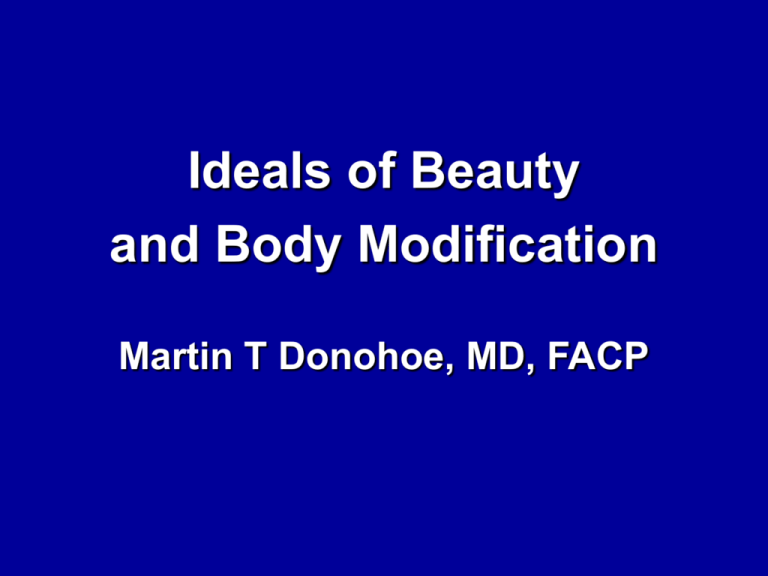
Ideals of Beauty and Body Modification Martin T Donohoe, MD, FACP Outline • Historical and contemporary ideals of beauty and methods of body modification • The obesity epidemic • Ethical and policy questions Historical Ideals of Beauty • Ancient Greeks valued symmetry • Contemporary definitions similar: – “Ideal woman”: small chin, delicate jaws, full lips, small nose, high cheek bones, large and widely spaced eyes, and waist:hip ratio of 0.7 – “Ideal man”: taller, waist:hip ratio of 0.9, dominant/rectangular face/chin, deep-set eyes, heavy brow • Suggests strong supply of testosterone Historical Ideals of Beauty • Chinese foot binding – pain, osteoporosis, falls/imbalance – Surgery to reshape women’s feet for stiletto heels increasingly popular • Ancient Greek newborn female baby wrapping • Ancient Egyptians/Roman/Persians: antimony for conjunctival sparkle Historical Ideals of Beauty • Elizabethan hair plucking, ceruse makeup • Court of Louis XVI: blue veins drawn on neck and shoulders to emphasize noble blood • 16th & 17th century: belladona eye drops Historical Ideals of Beauty • 18th Century: vermillion makeup (sulfur and mercury) • 14th - 19th century: corsetting (whalebone and steel) – precursor to the girdle – Making a comeback at both high- and lowend retailers (takes up to 30 minutes to lace up; requires an extra set of hands) Contemporary Ideals of Beauty • Breast implants (since 1903 - Charles Miller, MD) – First silicone breast enlargement 1962 • “Better Baby Contests” – Eugenic Movement / Social Darwinism • Tapeworms (Maria Callas) • Rib removal (Cher?) Contemporary Ideals of Beauty • Botox injections • Plastic surgery • Abusive subjugation of women through body modification – female genital mutilation – Cultural components Ideals of Beauty • Brass neck rings (Paduang people of Burma) • Lip and earlobe expanders (certain African tribes) • Tattoos, body piercings, wings Ideals of Beauty • Wonderbra, Brava Bra ($2500, suction device worn overnight for 10 weeks, promises 1 cup increase, can cause skin rash, discomfort) • Wonderbum pantyhose (DuPont Lycra) – promises a “perfectly peachy, pert bottom” • Music industry depictions of beauty Ideals of Beauty • Ancient Greeks – symmetry – Remains true – Familiarity, personality traits also important • Evolutionary adaptation for survival of human species – Size, muscle power, pathogen-free status, fertility The Perks of Beauty • The good-looking are more likely to get married, be hired, get paid more, and be promoted sooner • Height is associated with income and leadership positions • Strangers are more likely to assist good-looking people in distress The Perks of Beauty • The pretty/handsome are less likely to be reported, caught, accused, or punished for a minor or major crime • Role of ageism (more important for women) • The responsibility: – Attractiveness is recognized as a special gift, and its misuse is not tolerated Cosmetics • Concocted at home prior to 20th Century • Industry spawned by: – “Allure” of prostitutes/sexuality – Mass popularity of anti-aging products in 1920s – Women entering workforce – Migrations to cities • Food, Drug and Cosmetic Act (1938) Cosmetics • 2004 spending = $12 billion – 33% more than the amount needed each year (in addition to current expenditures) to provide water and sanitation for all people in developing nations – Slightly more than the amount needed each year (in addition to current expenditures) to provide reporductive healthcare for all women in developing countries Cosmetics • Average American adult uses 9 personal care products/day (with 126 unique chemical ingredients) –89$ of the over 10,500 ingredients used in personal care products never tested for toxicity –Little FDA oversight Cosmetics and Hair Coloring • Women devote average of 19 minutes per day to treating and altering their faces • ½ of American women between 13 and 70 color their hair –1/8 American men between 16 and 60 Tanning • The skin’s response to ultraviolet light injury • No such thing as a “safe tan” • 95% of Americans understand that sunburns are dangerous, but 81% still think they look better with a tan. Artificial Tanning • 47% of college students use a tanning lamp each year (females more than males) • 39% have never used a tanning lamp • More than 90% of users are aware that premature aging and skin cancer are possible complications of tanning lamp use Tanning • Tanning as a substance abuse-like disorder • Tanning produces endorphins • Most countries do not limit access of youths to tanning parlors • SPF of at least 15 should be worn when outdoors (and re-applied frequently) Artificial Tanning • Many lotions and creams available • Burgeoning industry • “Natural” does not necessarily mean safe Tattooing • Tattoo from Tahitian word “tatau” (“to mark”) • Reached apogee among Maori • Popularized in West by sailors returning from Polynesia Tattooing • Aesthetic choice • Initiation rite • Time-saving way for disabled to overcome difficulties of applying makeup • Adjuvant to reconstructive surgery (particularly face and breast, to simulate natural pigmentation) Tattooing • 30 million Americans have tattoos • Ancient practice: Maori tribesmen, Thracian women of 5th Century Greece • Tattooing still illegal in South Carolina and Oklahoma Tattooing • More than 50 different pigments and shades employed – None approved for skin injection – Some industrial grade printer’s ink or automobile paint The Fringes • Anal bleaching – Initially porn stars and sex workers – Now available to general public for $75/treatment – Can cause eczema • Money: Jim Nelson auctioned off his head on eBay for a corporate logo tattoo in 2003 Risks of Tattooing • Tattooing associated with risky behaviors in adolescents • Infection – e.g., hepatitis B, C, and HIV – Am Assn Blood Banks requires one-year wait between getting tattoo and donating blood • Removal problems • Allergic reactions Risks of Tattooing • • • • • Granulomas Keloid formation MRI complications Swellings/burns Image quality suffers (particularly with permanent mascara) The Most Common Problem: Dissatisfaction • 17% of those tattooed later regret it – Chief reason = the person’s name in the tattoo • Practitioners’ skill levels vary widely • Fading with time • Blurring when injections too deep The Most Common Problem: Dissatisfaction • Human body changes with time • Styles come and go • With facial cosmetic surgery, appearance of tattoos and permanent makeup may become distorted Tattoo Removal Techniques • • • • • • Laser treatments Dermabrasion Salabrasion Scarification Surgical Removal Camouflaging Temporary Tattoos • Fade after several days • Allergic reactions • FDA alert re risks with foreign-made products Risks of Henna Tattoos • Henna products risky – Henna approved for use as a hair dye, not for injection into the skin – Produces a reddish-brown tint, raising questions about what ingredients are added to produce the varieties of colors labeled as henna (e.g., “black henna,” “blue henna” Botox • Botulinum toxin: – Cause of botulism – potential biowarfare/bioterror agent • Medical Uses: blepharospasm, spasmodic torticollis, migraines, back spasms, chronic pain, axillary hyperhidrosis, wrinkles due to normal aging • Unlikely to work on sun- or smoking-induced wrinkles Botox • Manufacturer = Allergan • 3.8 million treatments in 2005 (costing $1.4 billion) • Large direct-to-consumer ad campaign expected • $80/dose + physician’s fee ($300 to $1,000) Botox • Most users white, age 35-50 • 12% are men • In-home Botox parties; Botox scams • Hollywood actors Botox • Retreatments required q 3-4 months • Side effects: masklike facies, slackness and drooling, rare allergic reactions • Rivals = collagen injections (from cows, possible allergic responses), Perlane (“natural” collagen alternative from human tissue), Myobloc, fat injections, face lift/eyelid surgery Dermal Fillers • Alternative to botox • 33% increase in use compared to 2001 • Cow collagen, liquid silicone, plastic microbeads, synthetic bone and ground-up human cadaver skin (association with for-profit tissue banks) Dermal Fillers • $700-$900 per treatment (lasts a few months) • Compare with $4000-$6000 for a facelift, which lasts 10-15 yrs before requiring touch-ups Conclusions • Ideals of beauty: some relatively constant, others change • Multiple methods of body modification: some dangerous, even abusive Covered in Other Slide Shows • Cosmetic surgery • Female genital cutting • Body weight and the obesity epidemic • Ethical and policy issues References • Donohoe MT. Beauty and body modification. Medscape Ob/Gyn and Women’s Health 2006;11(1): posted 4/19/06. Available at • http://www.medscape.com/viewarticle/529442 • Donohoe MT. Cosmetic surgery past, present, and future: scope, ethics and policy. Medscape Ob/Gyn and Women’s Health 2006;11(2): posted 8/28/06. Available at http://www.medscape.com/viewarticle/542448 Contact Information Public Health and Social Justice Website http://www.phsj.org martindonohoe@phsj.org
